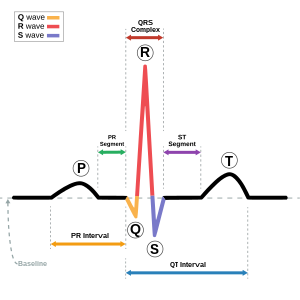PR interval
Period in electrocardiography

In electrocardiography, the PR interval is the period, measured in milliseconds, that extends from the beginning of the P wave (the onset of atrial depolarization) until the beginning of the QRS complex (the onset of ventricular depolarization); it is normally between 120 and 200 ms in duration. The PR interval is sometimes termed the PQ interval.
Interpretation
Variations in the PQ interval can be associated with certain medical conditions:
- Duration
- A long PR interval (of over 200 ms) indicates a slowing of conduction between the atria and ventricles, usually due to slow conduction through the atrioventricular node (AV node).[1] This is known as first degree heart block.[1] Prolongation can be associated with fibrosis of the AV node, high vagal tone, medications that slow the AV node such as beta-blockers, hypokalemia, acute rheumatic fever, or carditis associated with Lyme disease.[2][3]
- A short PR interval (of less than 120ms) may be associated with a Pre-excitation syndromes such as Wolff–Parkinson–White syndrome or Lown–Ganong–Levine syndrome, and also junctional arrhythmia like atrioventricular reentrant tachycardia or junctional rhythm.
- A variable PR interval may indicate other types of heart block.[citation needed]
- PR segment depression may indicate atrial injury[4] or pericarditis.[5]

See also
- P wave
References
- ^ a b Clinical cardiac electrophysiology in clinical practice. Huang, David T.,, Prinzi, Travis. Berlin. December 2014. ISBN 978-1-4471-5433-4. OCLC 897466910.
{{cite book}}: CS1 maint: location missing publisher (link) CS1 maint: others (link) - ^ Karacan M, Ceviz N, Olgun H (2012). "Heart rate variability in children with acute rheumatic fever". Cardiol Young. 22 (3): 285–92. doi:10.1017/S1047951111001429. PMID 21933462. S2CID 25845504.
- ^ Costello, J. M.; Alexander, M. E.; Greco, K. M.; Perez-Atayde, A. R.; Laussen, P. C. (2009). "Lyme Carditis in Children: Presentation, Predictive Factors, and Clinical Course". Pediatrics. 123 (5): e835–41. doi:10.1542/peds.2008-3058. PMID 19403477. S2CID 25270378.
- ^ Rao, B.N. Vijay Raghawa (2009). "Evolution of ECG Changes". Clinical Examinations in Cardiology. pp. 561–2. ISBN 978-81-312-0964-6.
- ^ Pedley, D. K.; Brett, C; Nichol, N (2002). "P-R segment depression: An early diagnostic feature in acute pericarditis: A telephone survey of UK accident and emergency departments". European Journal of Emergency Medicine. 9 (1): 43–5. doi:10.1097/00063110-200203000-00010. PMID 11989495. S2CID 22919251.
- v
- t
- e
| Cardiac output | |
|---|---|
| Ultrasound |
|
| Heart rate |
|
| Conduction | |
| Chamber pressure | |
| Other |
hemodynamics
| Blood flow |
|
|---|---|
| Blood pressure | |
| Regulation of BP |












